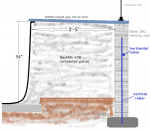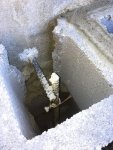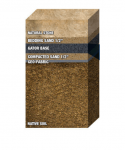I had a discussion with our inspector about the steel rebar in our pool's retaining wall being tied into the bonding loop. (pictures below).
He noticed that I had a stub-out piece of 8g copper coming out of the each section of the wall. It is clamped to the rebar (vertical in the footing wire-tied to a horizontal bond beam). I told him I am going to attach those wires to the bonding wire loop under the pavers later. He said he would not have required me to put this in but had no issues with it.
My read of the code is that is not needed, as well, but I do think it will help equalizing the potential in the narrow deck area.
Any thoughts on this?
----------------
Our overall design is this with a retaining wall on 3 sides of the pool.............

The wall cross section is like this with vertical steel rebar in the footing, tied to a horizontal rebar in a bond beam running the perimeter.........


He noticed that I had a stub-out piece of 8g copper coming out of the each section of the wall. It is clamped to the rebar (vertical in the footing wire-tied to a horizontal bond beam). I told him I am going to attach those wires to the bonding wire loop under the pavers later. He said he would not have required me to put this in but had no issues with it.
My read of the code is that is not needed, as well, but I do think it will help equalizing the potential in the narrow deck area.
Any thoughts on this?
----------------
Our overall design is this with a retaining wall on 3 sides of the pool.............

The wall cross section is like this with vertical steel rebar in the footing, tied to a horizontal rebar in a bond beam running the perimeter.........





